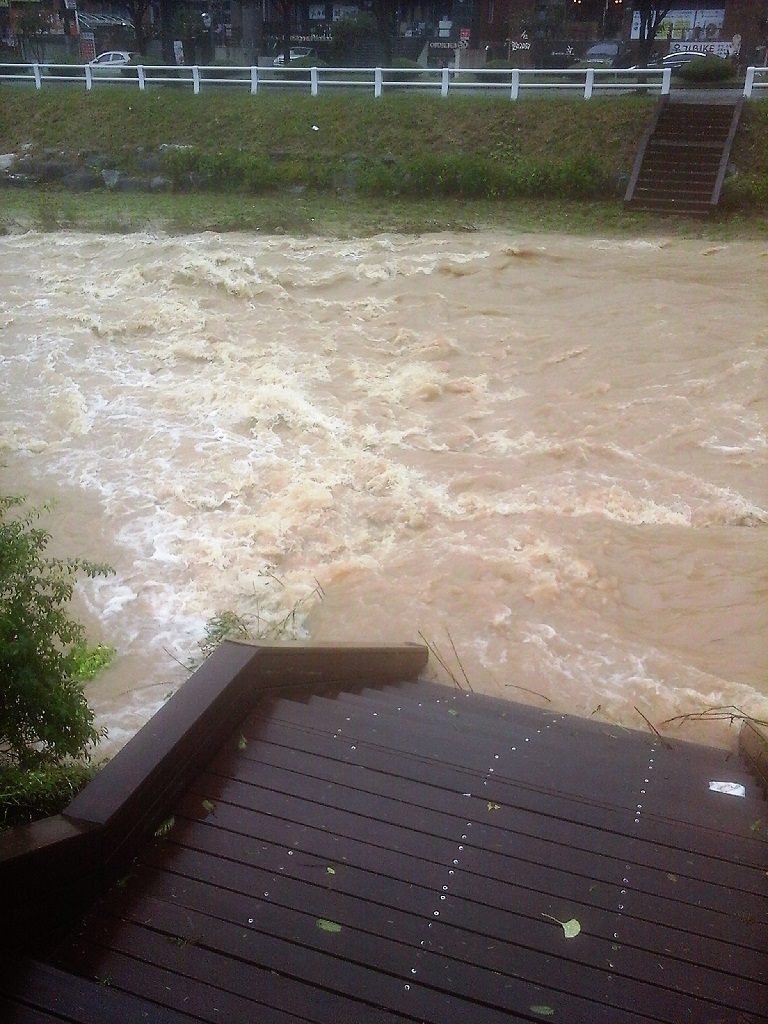How “The News” Works
“Fake news.” The problem with Trump’s popular expression, apart from the dishonestly selective manner in which he uses it, is that the phrase is redundant. What we call “news” today is fake by definition. Hence, calling any media outlet “fake news” is like calling someone a “dishonest liar.” News is just opinion-mongering, propagandizing, commercial advertising, and political insinuation by another name. I will share an amusing example of what I mean, one which occurred over the past eighteen hours here in Limbo. In other words, this is Breaking News!
Late Thursday afternoon here in Korea, which would mean the very early hours of Thursday morning in North America, I was greeted on the default Microsoft News page with a headline, “Tropical Storm Barry forms in Gulf, possible hurricane.” The headline was accompanied by a photo of two black women with young children in their arms, trekking through a flooded street.
What struck me as odd about this photograph, which, along with the headline, was obviously part of the usual climate-change-is-urgent-and-Republican-presidents-don’t-care-if-black-people-die propaganda circuit, was that neither the women nor the children in this picture looked in any way distressed or desperate. After all, I thought, the purpose of such a photo is purely to create an impression of dire threat, and specifically a dire threat to helpless, abandoned black people. So why show the ladies looking so unpanicked. The streets of their neighborhood were flooded after a rain, so they were trudging through the shin-deep water with their small children in their arms to make sure they were safe. No big deal.
Immediately, I noted that this picture was a strange failure, from the point of view of the news organization that had posted it, since there would be no reason for such optics if not to suggest tragedy and impending doom, i.e., to foment mock agony and ersatz empathy among online viewers. And yet the subjects of this photograph were just handling a practical difficulty calmly, without alarm or desperation. They seemed like normal adults, taking care of their children during a middling flood, the sort of event that is fairly common in certain cities, due to altitude, seasonal weather, and so on. Here on the south coast of Korea, I too live in a hurricane zone — we call them “typhoons” — in a city surrounded (like all Korean cities) by mountains; and so I have trudged through flooded streets like that a few times myself. No fun at all, and if I were with very young children, I would undoubtedly pick them up and carry them through the deepest parts in my arms, as those ladies were doing in the picture.
So imagine my delight when, very early Friday morning, and hence Thursday afternoon in most of North America, I opened the same MSN homepage and saw the same headline, with the same picture — except that I noticed it wasn’t quite the same picture at all. Like Dorian Gray noticing that the smile on his portrait had suddenly changed to a hint of a sneer, I blinked a few times and looked at the picture again.
Now, only one of the original ladies was in the photograph, carrying two little boys, one in each arm. And fascinatingly, today the stoic, mildly strained expression of a person carrying two boys while walking through shin-deep water — her mien in yesterday’s picture, the one I thought so ill-suited to the news agency’s obvious shock-and-tears intentions — had changed. Suddenly, the woman had a look that suggested pain, desperation, or terror, quite the opposite of the previous photo, though she appeared to be in more or less the same situation as in yesterday’s shot.

As a pretty serious hobby photographer, I know how easy it is to take a photo of a person in motion and then realize that at the moment you clicked, her expression was suggestive of distress or confusion, though in fact nothing significant was happening. And if you look at the above photo, you will notice that the woman appears to be shouting something, either to the children or to someone beyond the frame, which naturally distorts the mouth in a way that, if captured at just the right moment, could look like an expression of distress. Furthermore, you can see that the two boys in her arms look relaxed and curious, with one of them even glancing directly at the photographer.
In fact, it turns out, if you click on the actual story and scroll down to where this photo appears again, you can read the tiny caption, which informs us that this woman was carrying the boys across the street to their mother, but at the moment the photographer happened to click that particular frame, she had felt something at her feet under the water, and was therefore momentarily surprised, as anyone would be.
There was no emergency here, no crisis, no terror, as the original photo of the same woman and the shallowness of the floodwaters prove. She was just a little surprised by something insignificant. But the photo, knowingly featured, upon review, by explicit editorial choice, in isolation from its real context, and accompanied with a headline featuring the word “hurricane,” evokes thoughts of disaster and heartbreak.
So there you have it. Early on Thursday morning, U.S. time, a news site posted a headline about a “possible hurricane” brewing in the Gulf of Mexico. To accompany this headline, they chose the alarmist optics of flooding and escape, using a recent picture of two black women wading through shallow waters on a New Orleans street after a heavy rain. Someone, presumably an editor, saw the picture and decided the people in it did not look frightened or endangered enough for his or her purposes. To correct this deficiency — “Where’s the news angle?” — this editor ordered the photo replaced with a “better” one, which is to say one that does a better job of creating the sense the editor was hoping for, namely “African-Americans and their children in grave danger.”
In other words, to speak redundantly, this was “fake news.” Or to state it more correctly, news.



